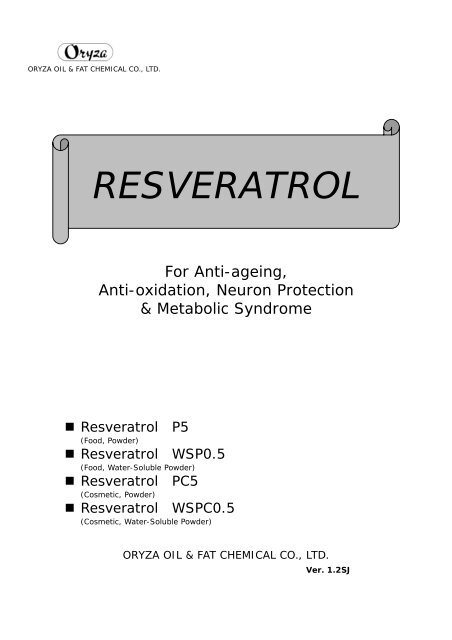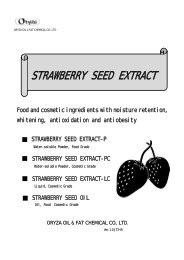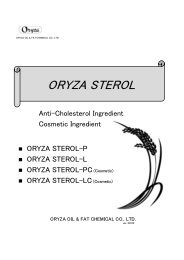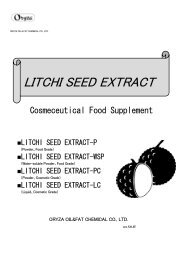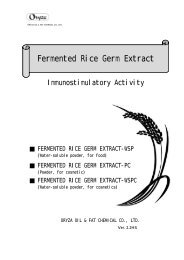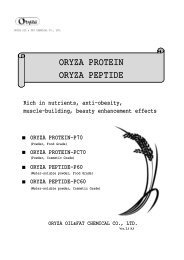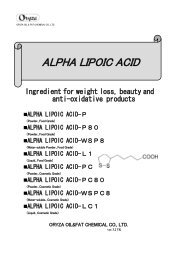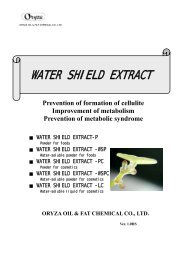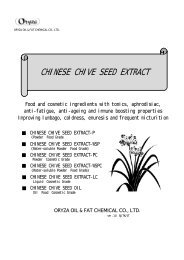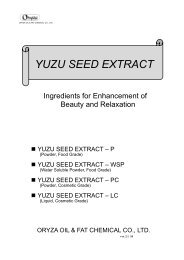RESVERATROL
RESVERATROL
RESVERATROL
Create successful ePaper yourself
Turn your PDF publications into a flip-book with our unique Google optimized e-Paper software.
ORYZA OIL & FAT CHEMICAL CO., LTD.<strong>RESVERATROL</strong>For Anti-ageing,Anti-oxidation, Neuron Protection& Metabolic Syndrome• ResveratrolP5(Food, Powder)• ResveratrolWSP0.5(Food, Water-Soluble Powder)• ResveratrolPC5(Cosmetic, Powder)• ResveratrolWSPC0.5(Cosmetic, Water-Soluble Powder)ORYZA OIL & FAT CHEMICAL CO., LTD.Ver. 1.2SJ
<strong>RESVERATROL</strong> Ver. 1.2SJCONTENTS1. Introduction 22. Anti-ageing42-1. What is it Called Ageing?2-2. Extension of Lifespan3. Anti-oxidation63-1. UV and Mental Stresses Accelerate Ageing3-2. SOD-like Activity, DPPH Free Radical Quenching Activity4. Beauty Stuffs74-1. Tyrosinase Inhibition (in vitro)4-2. Hyaluronidase Inhibition (in vitro)4-3. Collagenase Inhibition (in vitro)4-4. Elastase Inhibition (in vitro)4-5. Anti-inflammation5. Anti-bacteria105-1. P. acnes5-2. H. pylori6. Metabolic Syndrome116-1. Lipid Metabolism (in vitro)6-2. Cardiovascular Diseases6-3. Diabetes6-4. Lipid Accumulation (in vitro)7. Neuron Protection137-1. Protection against Cellular Damage Caused byAmyloid-beta Peptide (in vivo)7-2. Protection against Oxidative Stresses (1) (in vivo)7-3. Protection against Oxidative Stresses (2) (in vivo)8. Monitor Tests 169. Experimental Methods & Citations 1810.-17. Product Guide 19Product Standards 241
<strong>RESVERATROL</strong> Ver. 1.2SJFor Anti-ageing,Anti-oxidation, Neuron Protection& Metabolic Syndrome<strong>RESVERATROL</strong>1. IntroductionThe grape is the most-widely cultivated fruit in the world. People have been eating grapes for overeight thousands years and we cannot speak about the history of mankind without mention of grape.Ancient Egyptians made offerings of red wine to their gods and Christians use it to represent theblood of Jesus Christ in ceremonies. During the Tang dynasty in China, wine stimulated people’sinterest about the west (Persia and other countries). Currently, eighty percent of the grapescultivated in the world are used to make wine.Grape skin contains polyphenol known for its high antioxidant activity. The purple color ofgrape skin is of anthocyanin-family polyphenol, the same family of blueberry, believed to maintaingood eyesight. A growing awareness about Resveratrol as a characteristic component of grapehas caught people’s attention.Resveratrol was discovered in 1940 and reported to be contained in red wine in 1992. It hasbeen enthusiastically studied as its cancer prevention activity was first reported in 1997. Everyyear over 1,000 academic papers are cited about it.Resveratrol is now believed to perform various activities including life extension by controllingenergy generation, cell division, etc. Increased studies about resveratrol will continue to uncovernew findings.Oryza Oil&Fat Chemical has released the natural ingredient “Resveratrol” developed byconcentrating resveratrol with the pigment compositions in grape. New data is also available.Please use Resveratrol to maintain your beauty and health.2
<strong>RESVERATROL</strong> Ver. 1.2SJChemical FeaturesGrape and red wine are rich inpolyphenols such as catechin, gallic acid,tannins and anthocyanins (pigment).Resveratrol is contained in grape,cowberry or Polygonum plants, andpresents mainly as trans form in nature(Scheme 1). A glycoside called piceiddissolve in water, and is found in redwine.Resveratrol-P5 (PC5) is made fromgrape, being proven by fingerprints (Fig.1). Polyphenols other than resveratrolpresent in it and play an important roletogether with trans-resveratrol.trans-ResveratrolpiceidScheme 1. Chemical Structures of trans-resveratrol and piceid.Fig. 1. PolyphenolicFingerprints of grapeextract (top) andResveratrol-P5 (bottom)HPLC charts ofdetection wavenumbersof 306 nm. Arrowsshow trans-resveratrol.3
<strong>RESVERATROL</strong> Ver. 1.2SJ2. Anti-ageing2-1. What is it Called Ageing?In general, over sixty percent of women regard ageing as something that they want to avoid orsomething threatening. For most women, ageing means ageing of skin.Ageing also means higher risk of diabetes or cancer. Do you feel that you gain weight easieras compared to when you were younger? This is because of poor metabolism, unbalancedhormones, and dull hormone sensitivity. The risk of circulatory system diseases such as cardiacarrest also increases as you age. Brain (nerve) disorders such as Alzheimer’s disease are alsothings to be concerned about while brain atrophy causes a decline in memory.These ageing phenomena are closely related to the decline in bodily functions. The key toanti-ageing is the activation of the body’s functions.Brain functionsSkinLiverBuilt in blubberVisceral fatHeart, Blood,Blood vesselCancerFig. 2 Various Problems that Appear Due to Ageing2-2. Extension of LifespanIn 2006, a revolutionary thesis on resveratrol’s life extension was released. According to the thesis,resveratrol’s life extension was first confirmed on a mammal (mice). (Baur JA et al., Nature, 444(7117), 337-342, 2006)The author of the thesis stated that he had conducted a preliminary test on over 20,000 types ofcompounds and resveratrol showed the most promise for the ability to extend life. He conductedtests and proved its life extension on mice.“Life-span factor” or “life-span gene” on higher animals has not been discovered yet. However,if the actions of enzymes can be re-activated after their functions decline due to ageing, thefunctions of a young body can be regained. This is because actions of enzymes are the source ofbodily functions.The human body has a protein called SIRT-1 that activates another protein called PGC-1alphawhich is activated when the body lacks energy. The activation increases the sensitivity tohormones such as insulin and a gene induces the absorption of sugar and lipids in blood into cells(Fig. 3). Namely, PGC-1alpha helps the body to be ready for ingestion of meals and promotes theefficient use of remaining energy to be ready for hunger (maintenance of homeostasis, Fig. 4).However, a continuous high-calorie diet inhibits this regulating function and affects homeostasis ofthe body (Fig. 4). Although only a small percentage of people have hyperlipemia or diabetes, manypeople today seem to ingest too many calories.4
<strong>RESVERATROL</strong> Ver. 1.2SJA unique feature of resveratrol is its function to activate the metabolic pathway through SIRT-1even in people with a high-calorie diet. In other words, it activates metabolism through the samepathway utilized during fasting. No other known material performs like this.SIRT-1-homologous protein exists in lower creatures like nematode worms and works activelyunder low nutrient conditions. As a result, nematode worms, cultivated under the conditions live1.5 times longer than the ones cultivated under regular nutrient conditions. It has been confirmedthat adding resveratrol to yeast, nematode worms, and fruit flies extends their life. Many people inthroughout the world are interested in resveratrol and want to know if it can extend mammalian lifeas well.Athletic, Exercise, Undernourishmentlow nutrient conditionResveratrolResveratrol inhibits acetylation andincreases the percentage ofactivated type PGC-1α.AcetylationActive Activated typetypeNon Inativated active typeReceptorNuclear receptorGene expresses.Expression;Metabolism is activated and insulin sensitivity increases.Metabolism activation, increase in insulin sensitivity, orSerum lipid level lowers.decrease in serum lipid levelFig. 3 Example of Actions of the SIRT-1 GeneHungerOther biologic reactionContinuous high-calorie dietWeaker reactionOther biologic reactionInsulin sensitivityincreasesMetabolism is activated.Insulin sensitivity decreases.Metabolism is inactivated.Serum lipid/blood glucoselevels decrease.Other biologic reactionHomeostasis ismaintained.Serum lipid/blood glucoselevels increase.Other biologic reactionSerum lipid/blood glucose levels increase.Cardiac disease, diabetes, fatty liverFig. 4 Continuous High-calorie Diet Inhibits the Maintenance of Metabolic Homeostasis.5
<strong>RESVERATROL</strong> Ver. 1.2SJ3. Anti-oxidation3-1. UV and Mental Stresses Accelerate AgeingUV ray is known to cause tan and dark spots and is deeply related to skin’s ageing. It producesreactive oxygen species to make the skin coarse and less elastic. Reactive oxygen species are alsoproduced by stress. This is why stress if often thought of as an archenemy of the skin.Studies on animals confirmed that resveratrol prevents damage on DNA caused by UV ray,increases the anti-oxidative potency in serum, decreases lipoperoxide (lipids damaged by reactiveoxygen species), and also controls the activity of the inflammation transcription factor NF-кB(chapters 4 and 5).3-2. SOD-like Activity, DPPH Free Radical Quenching ActivityResveratrol has been confirmed to perform extremely strong SOD-like activity (Fig. 5) and DPPHradical scavenging activity (Fig. 6) that are indexes of anti-oxidative potency. This indicates thatresveratrol can protect living bodies from reactive oxygen species.SOD mimicking activity (%)1007550250Resveratrol-P510 30 100 300Reaction concentration (ppm)Fig. 5. SOD-like activityScavenging activity (%)1007550250Resveratrol-P510 30 100Reaction concentration (ppm)Fig. 6. DPPH radical quenching activity6
<strong>RESVERATROL</strong> Ver. 1.2SJ4. Beauty Stuffs4-1. Tyrosinase Inhibition (in vitro)Melanin is a cause of dull skin and dark spots and is produced by the enzyme tyrosinase in the body.Resveratrol is expected to inhibit the activity of the enzyme to control melanin production andperform brightening effect.The inhibitory effect was studied resveratrol showed concentration-dependent inhibition ontyrosinase (Fig. 7).Tyrosine Dopa Dopaquinon BlackMelaninTyrosinaseTyrosinaseResveratrol-P5Tyrosinase inhibitory rate (%) Reaction concentration (ppm)Fig. 7. Tyrosinase InhibitionTable 1. Tyrosinase Inhibition at 100 mM of either resveratrol (pure substance) or Kojic acidTyrosinase Inhibition (%)MushroomMouse B16 MelanomaResveratrol (pure substance) 63.8±3.8 32.7±5.1Kojic acid 76.7±1.1 43.0±2.5Kim et al., Oxyresveratrol and hydroxystilbene compounds. Inhibitory effect on tyrosinase and mechanism ofaction. J. Biol. Chem., 277(18), 16340-16344, 2002.7
<strong>RESVERATROL</strong> Ver. 1.2SJ4-2. Hyaluronidase Inhibition (in vitro)Hyaluronic acid is a water-retentive high polymer widely distributed in the skin, joint fluids,vitreous bodies, and ligaments of living organisms. In the skin, hyaluronic acid is involved inbonding and protecting cells and also maintaining the skin’s moisture content and elasticity.Hyaluronic acid content is believed to decrease according to age. When inflammation occurs onthe skin due to UV ray exposure or other causes, hyaluronidase (degradative enzyme) is activated toaccelerate the degradation of hyaluronic acid. Lack of hyaluronic acid results in less moisture andfirmness on the skin and eventually dark spots and sagging.Resveratrol’s hyaluronidase activity inhibitory effect was studied and the results showed itsconcentration-dependent effect apparently. (Fig. 8)Hyaluronidase inhibition (%)100806040200Resveratrol-P510 30 100 300Reaction concentration (ppm)Fig. 8. Hyaluronidase Inhibition4-3. Collagenase Inhibition (in vitro)Seventy percent of the dermis of the skin is collagen which is distributed throughout the entiredermis. Namely, collagen is the architecture of skin tissue and maintains the skin’s suppleness andstrength at an adequate level. However, when inflammation occurs on the skin due to UV rayexposure or other causes, collagenase (degradative enzyme) is activated to accelerate the degradationof collagen. Lack of collagen causes skin ageing signs such as wrinkles and sagging.Resveratrol’s collagenase activity inhibitory effect was studied and the results showed itsconcentration-dependent effect apparently. (Fig. 9)Collagenase inhibition (%)100806040200Resveratrol-P510 30 100 300Reaction concentration (ppm)Fig. 9. Collagenase Inhibition8
<strong>RESVERATROL</strong> Ver. 1.2SJ4-4. Elastase Inhibition (in vitro)Elastin is a protein contained in the skin like collagen and is linked to the skin’s elasticity. However,when inflammation occurs on the skin due to UV ray exposure or other causes, elastase (degradativeenzyme) is activated to accelerate the degradation of elastin. Lack of elastin causes skin ageingsuch as wrinkles and sagging.Resveratrol has been proven to inhibit elastase at low concentration and control the degradationof elastin. (Fig. 10) Elastase inhibition (%)4-5. Anti-inflammationResveratrol performs its antiinflammatoryactivity by controllingthe action of transcription factor NF-кB.NF-кB is involved in inflammatoryreactions and the increase of cancercells.Normally, NF-кB is inactivated by asuppressor. However, it is activatedwhen the suppressor is dissociated fromNF-кB by an external factor such asUV ray and bacterial infection. Studieshave proved that resveratrol inhibits thesuppressor dissociation stage (tomaintain NF-кB inactivated).Resveratrol seems to controlredness, progression of pimples, anditch by inhibiting the production ofinflammatory factor. Resveratrol-P5 Reaction Concentration (ppm)Fig. 10. Elastase InhibitionNF-B(activated type)SuppressorThe suppressor is phosphorylated anddissociated from NF-BNF-B bonding siteGene expresses.Production of inflammatoryfactor, cancer progressionNF-B(inactivated type)InhibitionResveratrolCellnucleusFig. 11. Schematic Illustration of Anti-inflammationMechanism9
<strong>RESVERATROL</strong> Ver. 1.2SJ5. Anti-bacteria5-1. P. acnes (in vitro)Acne is considered to occur and progress due to P. acnes, which is resident microbiota in hairfollicles of human skin.P. acnes multiplies using sebum as the source of nutrient and produces lipase. Lipase degradestriglyceride in sebum, frees fatty acid, and induces a series of inflammatory reactions; white bloodcells’ go astray and infiltration to the dermis and release of inflammatory factor. The inflammatoryfactor irritates the skin and accelerates the cornification of the epidermis in addition to inflammation.A test, where resveratrol was added to an agar medium, proved that it controls the multiplication of P.acnes (antibacterial activity) at the concentration of 300 µg/ml or higher (Fig. 12).Since resveratrol has a strong anti-inflammatory activity, it is expected to control acne and itsprogression by performing its antibacterial activity as well.ControlResveratrol 1000 µg/mLSpotSpotFig. 12 Resveratrol’s Anti P. acnes ActivityDMSO or resveratrol (1,000 µg/ml) was dropped on the spot at the center, and cultivated. The entirephoto in the left looks whitish because P. acnes spread all over the area. In the photo at right,resveratrol inhibited the multiplication of P. acnes around the spot (area inside the white dotted line).n=2.5-2. H. pylori (in vitro)H. pylori is a bacterium considered to cause gastric ulcer and stomach cancer and lives in thestomach. Japanese people have a high H. pylori-carrying rate. Over fifty percent of people intheir sixties or older have the bacterium. Prompt elimination is recommended when H. pylori isfound.Resveratrol’s antibacterial activity is effective on H. pylori and the effect has been proven by invitro tests. CLO test is a method to determine the quantity of ammonia produced by H. pylori.Chatterjee A, et, al. The bactericidal effects of Lactobacillus acidophilus, garcinol and Protykin compared toclarithomycin, on Helicobacter pylori. Mol. Cell. Biochem., 243 (1-2), 29-35, 200310
<strong>RESVERATROL</strong> Ver. 1.2SJ6. Metabolic Syndrome6-1. Lipid Metabolism (in vitro)As Japanese people now consume more fat because their dietary habits have become morewesternized. Excessive fat intake causes obesity, fatty liver, and hardened arteries.However, in some regions of the world, the incidence of vascular disease is low even thoughpeople in the regions have high-fat diets. This is known as the French paradox and many researchersare interested in it. Research results indicate that the French paradox is related to the consumption ofred wine.Molecular mechanisms are activelyinvestigated. Picard et al., demonstratedthat Sirt1 protein (chapter 2-2.) suppressedactivity of PPARγ nuclear receptor (Nature,429, 771-776, 2004.) in 3T3-L1 adiposeprogenitor cells. PPARγ nuclear receptorworks for adipose differenciation or fataccumulation in adipocytes. They culturedadipocytes with resveratrol, and founddecreased fat accumulation, enhanced freefatty acids release, etc. These resultssuggest that resveratrol moderate fatmetabolism. Please refer to chapter 6-4.<strong>RESVERATROL</strong>Free Fatty AcidsReleasedFat AccumulationDecreasedWhite Adipose Tissue6-2. Prevention of Cardiac DiseasesResveratrol has been reported to have an effect to prevent hardened arteries. It has been also reportedto lower the risk of cardiac diseases by controlling platelet aggregation. Resveratrol’s activity toprevent cardiac diseases is also widely known.6-3. DiabetesResveratrol has been reported to have activities to increase insulin sensitivityof high-calorie diet mice, increase lipid metabolism of diabetes model mice,reduce nerve pain, and protect neurons.11
<strong>RESVERATROL</strong> Ver. 1.2SJ6-4. Lipid Accumulation (in vitro)(1) 3T3-L1 Progenitor CellsReveratrol-P5’ activity to control fat accumulation was evaluated on fat cells where 3T3-L1 wasdifferentiation-induced.In visual observation on photomicrograph, the number and size of fat droplets were confirmed tobe reduced in area in a dose dependent manner. An absorbance measurement of oil red O stainedextract also clarified that resveratrol controls fat accumulation concentration dependently. Theseresults indicate that resveratrol could control fat accumulation.Fig. 13 Fat droplets (arrows) accumulated on 3T3-L1 differentiated cellsLeft: Control (DMSO), Right: Resveratrol (1 µg/mL) oil red O staining(2) VAC Visceral Fat CellsReveratrol-P5’ activity to control fat accumulation was evaluated on VAC visceral fat cells (rat).In visual observation on photomicrograph, the number and size of fat droplets were confirmed tobe reduced in a dose dependent manner. An absorbance measurement of oil red O stained extractalso clarified that resveratrol controls fat accumulation concentration dependently. These test resultsindicate that resveratrol has a strong fat accumulation control activity.Fig. 14. Fat droplets accumulated onVAC cellsLeft: Control (DMSO), Right: Resveratrol (100 µg/mL)12
<strong>RESVERATROL</strong> Ver. 1.2SJ7. Neuron Protection7-1. Protection against Cellular Damage Caused byAmyloid-beta Peptide (in vivo) In Alzheimer’s disease, a substance called amyloid-beta peptide accumulates in the brain,inducing cognitive impairment. Although detailed pathogenic mechanism is still unknown, neurondamage induced by amyloid-beta peptide is believed to be involved. Resveratrol has been proven toreduce cell damage induced by amyloid-beta peptide. Cell Viability (% of Control) Resveratrol (µg/mL) Fig. 15 Reduction of Neurotoxicity Induced by Amyloid Beta-peptide (Aβ)Resveratrol was added two hours after Aβ cell damage. When 20 µM of Aβ was added to rats’hippocampal neurons (gray bars) and cultivated together, nerves are damaged and the cell viabilitylowers. Resveratrol reduces cell damage.* p
<strong>RESVERATROL</strong> Ver. 1.2SJ7-3. Protection against Oxidative Stresses (2) (in vivo)In elderly people, cerebral ischemia is the most common neuron damage cause. Cortex andhippocampus are brain tissues responsible for judgment and memory. They are susceptible to theinfluence of temporary cerebral ischemia. When cerebral ischemia occurs, excitatoryneurotransmitter is released, active oxygen is generated, and neurons are eventually destroyed.In a test, both common carotid arteries ofrats were pinched to stop blood flow andcreate ischemic condition (reference: Fig.16). Resveratrol of 20 mg/kg wasadministrated through the tail veinimmediately after the operation to create anischemic condition.Fig. 17 is the graph of monitoringblood pressure, cerebral blood flow, andheart rate. Blood pressure lowered byapproximately 20% in the resveratroladministration group. This seems to becaused by resveratrol’s vasodilatoryactivity. Cerebral blood flow wassignificantly higher than the ischemiacontrol group (p
<strong>RESVERATROL</strong> Ver. 1.2SJTable 2. Nerve Damage ScoreGroupSham surgerycontrol groupIschemia controlgroupIschemia +resveratroladministration groupScore chart: mean±s.e., n=12,* p
<strong>RESVERATROL</strong> Ver. 1.2SJ8. Monitor TestsFour-week, successive intake monitor test was performed with subjects of healthy volunteers. Testoutline is as follows.Subjects Six males aged 42-63, four females aged 25-35.With no chronic syndromes.Period4 weeksTake one capsule a day in the evening.DoseResveratrol-P5, 40 mg/day8-1. Serum Contents (Serum Lipids)Total cholesterol Before 209.738.1(mg/dL) After 200.837.4LDL-cholesterol Before 127.533.5(mg/dL) After 103.520.0HDL-cholesterol Before 66.218.4(mg/dL) After 66.420.9TriglycerideBefore 74.030.8(mg/dL) After 65.933.2Free Fatty AcidBefore 0.440.31(mg/dL) After 0.450.17Fasted Blood Sugar Before 95.818.1Level (mg/dL) After 85.610.0AdiponectinBefore 7.133.34(µg/mL) After 7.333.35means.d. (N=10)8-2. Body Weight, BMI, Body Fat RatioBody Weight (kg)BMIBody Fat Ratio (%)means.d. (N=10)Before 58.610.9After 62.513.16Before 22.32.4After 22.06.7Before 22.46.5After 23.16.2LDL LDL-Cholesterol (mg/dL) Adiponectin (µg/mL)BMI18516013511085600.160.140.120.10.080.060.040.020BMI2827262524232221201918LDLLDL-CholesterolTriglyceride 1500 Before After Before After Adiponectin DiagnosedFasted Blood Sugaras high FBS140 Before AfterTriglyceride (mg/dL)Fasted Blood Sugar (mg/dL)BMIBody Fat Ratio35Body Fat Ratio (%) (%)10050120100806030252015Before After 10 Before After Before After [Graph Readings]Thin lines show values of individual subjects, before and after the test period. Bold line shows theaverage.16
<strong>RESVERATROL</strong> Ver. 1.2SJ8-3. Oxidative Stress MarkersSerum SODBefore 4.13.1(% Inhibition) After 6.22.4 p
<strong>RESVERATROL</strong> Ver. 1.2SJ9. Experimental Methods and CitationsFig. 5 Measured by SOD Test Wako (Wako Pure Chemical) kit.Fig. 6 Samples were added DPPH (1,1-diphenyl-2-picrylhydrazyl) solution, and thenthe optical density were measured.Fig. 7 Samples, dissolved in DMSO, were added to tyrosinase (mushroom origin)solution, and then the optical density, accompanies with the conversion ofL-tyrosin to dopa-quinone, were measured.Table 1 Kim et al., J. Biol. Chem., 277, 16340-16344, 2002.Fig. 8 Samples, dissolved in DMSO, were added to hyaluronic acid andhyaluronidase solution, and then the optical density, accompanies with theconversion of paradimethylaminobenzaldehyde, were measured.Fig. 9 Samples, dissolved in DMSO, were added to PZ-peptide and collagenasesolution, and then the optical density was measured.Fig. 10 Samples, dissolved in DMSO, were added to DQ-elastin and elastase solution,and then the fluorescence was measured.Fig. 12 P. acnes was pre-cultured in GAM liquid medium (Nissui Pharm.). Theculture was uniformly spread over GAM agar plates (Nissui Pharm.). At thecenter of the plate, a paper disk (8 mm in diameter) dropped by 80 µL ofsample solution. The disk was cultured for 48 hours.Fig. 13 3T3-L1adipocytes (4.010 4 cells/mL/well) were seeded in 24-well plates,andcultured for two days in DMEM containing 10% FBS, insulin (167 µM)isobutylmethylxanthin (0.5 µM), dexamethazon (1 µM). Then cells werecultured in DMEM containing 10% FBS, and the medium was exchanged inevery three days. Stained by oil red O.Fig. 14 VAC adipocytes (3.010 6 cells/mL/well) were seeded in 24-well plates, andcultured for two days in differenciation medium (Cell Garage Inc.). Mediumwas exchanged in every two days. In day8, medium containingnorepinephrin (2.010 -7 M) was added, and cultured for 6 hours. Cells werefixed by formaldehyde.Fig. 15 Han YS et al., Br. J. Pharmacol. 141(6), 997-1005, 2004.Figs. Lu KT et al., J. Agric. Food Chem., 54(8), 3126-3131, 2006.16-19Table 218
<strong>RESVERATROL</strong> Ver. 1.2SJ10. Stability(1) Thermal StabilityHeating of Resveratrol-P5 at 120 for an hour did not reduce resveratrol norpolyphenol contents therein.Initial = 100 Initial PolyphenolResveratrolFig. 20. Thermal StabilityHeating of Resveratrol-WSP solution (10% sucrose, pH4 with citric acid) atconcentrations of 0.1 or 0.03% at 80 for minutes did not reduce resveratrol norpolyphenol contents therein.Initial = 100 0.1% Solution 0.03% Solution Initial 10 min 30 min Initial 10 min 30 min PolyphenolResveratrolFig. 21. Solution Stability against Heat19
<strong>RESVERATROL</strong> Ver. 1.2SJ(2) pHResveratrol-WSP0.5 was dissolved in water of various pHs (pH3 to 7), and the solutionswere stored at room temperature and under natural lightning. One-week storage didnot reduce resveratrol nor polyphenol contents.Initial = 1000.1%Solution PolyphenolResveratrolFig. 22. Solution Stability against pHs(3) Solubility and ColorOne-week strage of Resveratrol-WSP solution (10% sucrose, pH4 with citric acid) atconcentrations of 0.1% at 80 for minutes did not cause cloudiness nor coloring.Cloudiness25(dark place)Stability (0.1% solution, pH4)40(dark place)5(dark place)None None NoneColoring None None None11. Safety Data(1) Residual agricultural chemicalsNone of the residual agricultural chemical (498 items) was detected in Resveratrol-P5.Test trustee: MASIS Co. LtdDate of analysis: July 2, 2007Test No. 1259020
<strong>RESVERATROL</strong> Ver. 1.2SJ(2) Acute Toxicity (LD50)Safety of Resveratrol-P10 was conducted according to the PharmaceuticalsGuidelines on Single-dose Toxicity Test. 2,000 mg/kg of Resveratrol-P10 (maximumdosage without burden on animals) was given to fasting ddY male/female mice of5-week old followed by close observation for 14 days. No fatal event and no abnormalchanges observed in the weight of mice (compared to control). Similarly, no abnormalchanges detected in organs of mice upon partial inspection conducted after the test. TheLD 50 (oral) of Resveratrol-P10 on male/female mice is deduced to be >2,000 mg/kg.(3) Sub-acute ToxicityToxicity on 28-day repeated dose was conducted on Sprague-Dawley male rats.Twenty mg/kg of pure resveratrol (equivalent to 400 mg/kg of Resveratrol-P5) wasgiven to rats without any restrictions on weight and test condition during the 28-dayperiod. No abnormal changes was reported in organs, weight and blood profile of ratsat end of test.Ref: Juan ME, Vinardell MP, Planas JM.The daily oral administration of high doses of trans-resveratrol to rats for 28 days is not harmful.J. Nutr., 132(2), 257-260, 2002.(4) MutagenicityMicronucleus Test was conducted and finding was negative. Resveratrol-P5 isconducted to be non-mutagenic.12. Nutrition FactDescription Resveratrol-P5 ResveratrolNote Analytical method-WSP0.5*Water 3.0g/100g 0.3g/100g Distillation methodProtein 2.4g/100g 0.2g/100g 1 Kjeldahl methodFat 1.8g/100g 0.2g/100g Soxhlet extractionmethodAsh 5.1g/100g 0.5g/100g Direct incinerationCarbohydrate 87.7g/100g 98.8g/100g 2Energy 377kcal/100g 398kcal/100g 3 Revised AtwatermethodDietary fiber 5.1g/100g 0.5g/100g Enzymatic weightmethodSodium 150mg/100g 15mg/100g Atomic absorptionspectrophotometory1. Nitrogen, protein, conversion factor: 6.252. Calculation: 100 – (water+protein+fat+ash+dietary fiver)3. Energy expression standard: protein 4, fat 9, sugar 4, dietary fiver 2Test trustee: SRL Co. LtdDate of analysis: June 28, 2007Test No. 200706150036* Calculated value21
<strong>RESVERATROL</strong> Ver. 1.2SJ13. Recommended DoseFrench people enjoy two to three glasses of wine a day in average, which may explainso-called French Paradox. Recommended dosage of 20-40 mg of Resveratrol-P5 or200-400 mg of Resveratrol-WSP0.5 daily is equivalent to the resveratrol intakeaccompanied with the wine consumption.14. Crude Drug EquivalentTwenty milligram of <strong>RESVERATROL</strong>-P5 (daily dosage) is equivalent to approximately200 to 1,000 mL of red wine, 1 kg of fresh grape (with skin), 2 litters of red grape juice,5 litters of cranberry juice, 200 g of boiled peanuts or 2 kg of peanut butter.Ref: Nature Rev. Drug Discov., 5, 493-506, 2006.15.Commercial ApplicationsApplications Claims ExamplesFoodCosmeticFor Beauty fromThe InsideTopicalAnti-Ageing,NeuronProtection,Antioxidant,Anti-Inflammation,MetabolicSyndrome Care,BeautifyingBeverages, hard/ soft capsules, tablets,candies, chewing gums, cookies,chocolates, wafers, jerry, etc.Body lotion, body gel, etc.Solubility in various media (at room temperature)water aqueous ethanol glycerol salad oil-P5 Bad Good Good Bad-WSP0.5 Good Good Bad BadResveratrol solutions in glycerol or 1,3-butylenglycol (BG) for cosmetic use isavailable.16. Packaging<strong>RESVERATROL</strong>-P5 (powder, for food),-WSP0.5 (water-soluble powder, for food)1 kg Interior packaging: Aluminium BagExterior packaging: Cardboard<strong>RESVERATROL</strong>-PC5 (powder, for cosmetic),-WSPC0.5 (water-soluble powder, for cosmetic)1 kg Interior packaging: Aluminium BagExterior packaging: Cardboard22
<strong>RESVERATROL</strong> Ver. 1.2SJ17. StorageStore in cool, dry dark place.18. Expression<strong>RESVERATROL</strong>-P5-WSP0.5 INCI Name<strong>RESVERATROL</strong>-P5-WSP0.5Grape ExtractCyclodextrin, Grape ExtractVitis Vinifera (Grape) Leaf/Skin/Seed ExtractMaltosyl Cyclodextrin (and) Cyclodextrin (and)Maltose (and) Vitis Vinifera (Grape) Leaf/Skin/SeedExtract23
<strong>RESVERATROL</strong> Ver. 1.2SJPRODUCT STANDARDPRODUCT NAME : <strong>RESVERATROL</strong>-P5 (FOOD)This product is extracted from grape (Vitis vinifera) leaves, seeds and fruit-skin with aqueousethanol. It guarantees minimum of 25.0 % polyphenols and of 5.0 % resveratrol.AppearancePurple to purple-brown powder with slight unique smell.Polyphenols Min. 25.0 % (Folin-Denis Method)Resveratrol Min. 5.0 % (HPLC)Loss on Drying Max. 10.0 % (Analysis for HygienicChemists,1g, 105 2 hr)Purity Test(1)Heavy Metals (as Pb) Max. 10 ppm (Sodium Sulfide Colorimetric Method)(2)Arsenic (as As 2 O 3 ) Max. 1 ppm (Standard Methods of Analysis in FoodSafety Regulation, The Third Method,Apparatus B)Standard Plate Counts Max. 1×10 3 cfu/g (Analysis for Hygienic Chemists)Moulds and Yeasts Max. 1×10 2 cfu/g (Analysis for Hygienic Chemists)Coliforms Negative (Analysis for Hygienic Chemists)Composition Ingredient ContentGrape Extract 100 %24
<strong>RESVERATROL</strong> Ver. 1.2SJPRODUCT STANDARDPRODUCT NAME : <strong>RESVERATROL</strong>-WSP0.5 (FOOD)This product is extracted from grape (Vitis vinifera) leaves, seeds and fruit-skin with aqueousethanol. It guarantees minimum of 2.5 % polyphenols and of 0.5 % resveratrol. This product iswater-soluble.AppearancePale purple powder with slight unique smell.Polyphenols Min. 2.5 % (Folin-Denis Method)Resveratrol Min. 0.5 % (HPLC)Loss on Drying Max. 10.0 % (Analysis for HygienicChemists,1g, 105 2 hr)Purity Test(1)Heavy Metals (as Pb) Max. 10 ppm (Sodium Sulfide Colorimetric Method)(2)Arsenic (as As 2 O 3 ) Max. 1 ppm (Standard Methods of Analysis in FoodSafety Regulation, The Third Method,Apparatus B)Standard Plate Counts Max. 1×10 3 cfu/g (Analysis for Hygienic Chemists)Moulds and Yeasts Max. 1×10 2 cfu/g (Analysis for Hygienic Chemists)Coliforms Negative (Analysis for Hygienic Chemists)Composition Ingredient ContentCyclodextrin 90 %Grape Extract 10 %Total 100 %25
<strong>RESVERATROL</strong> Ver. 1.2SJPRODUCT STANDARDPRODUCT NAME : <strong>RESVERATROL</strong>-PC5 (COSMETIC)This product is extracted from grape (Vitis vinifera) leaves, seeds and fruit-skin with aqueousethanol. It guarantees minimum of 25.0 % polyphenols and of 5.0 % resveratrol.AppearancePurple to purple-brown powder with slight unique smell.Polyphenols Min. 25.0 % (Folin-Denis Method)Resveratrol Min. 5.0 % (HPLC)Loss on Drying Max. 10.0 % (1 g, 105 2 hr)Purity Test(1)Heavy Metals (as Pb) Max. 10 ppm (The Second Method of The JapaneseStandards of Quasi-Drug Ingredients)(2)Arsenic (as As 2 O 3 ) Max. 1 ppm (The Third Method of The JapaneseStandards of Quasi-Drug Ingredients)Standard Plate Counts Max. 1×10 2 cfu/g (Analysis for Hygienic Chemists)Moulds and Yeasts Max. 1×10 2 cfu/g (Analysis for Hygienic Chemists)Coliforms Negative (Analysis for Hygienic Chemists)Composition Ingredient ContentVitis Vinifera (Grape) Leaf/Skin/Seed Extractand Resveratrol100 %26
<strong>RESVERATROL</strong> Ver. 1.2SJPRODUCT STANDARDPRODUCT NAME : <strong>RESVERATROL</strong>-WSPC0.5 (COSMETIC)This product is extracted from grape (Vitis vinifera) leaves, seeds and fruit-skin with aqueousethanol. It guarantees minimum of 2.5 % polyphenols and of 0.5 % resveratrol. This product iswater-soluble.AppearancePale purple powder with slight unique smell.Polyphenols Min. 2.5 % (Folin-Denis Method)Resveratrol Min. 0.5 % (HPLC)Loss on Drying Max. 10.0 % (1 g, 105 2 hr)Purity Test(1)Heavy Metals (as Pb) Max. 10 ppm (The Second Method of The JapaneseStandards of Quasi-Drug Ingredients)(2)Arsenic (as As 2 O 3 ) Max. 1 ppm (The Third Method of The JapaneseStandards of Quasi-Drug Ingredients)Standard Plate Counts Max. 1×10 2 cfu/g (Analysis for Hygienic Chemists)Moulds and Yeasts Max. 1×10 2 cfu/g (Analysis for Hygienic Chemists)Coliforms Negative (Analysis for Hygienic Chemists)Composition Ingredient ContentMaltosyl CyclodextrinCyclodextrin 90 %MaltoseVitis Vinifera (Grape) Leaf/Skin/Seed Extractand Resveratrol 10 %Total 100 %27
<strong>RESVERATROL</strong> Ver. 1.2SJORYZA OIL & FAT CHEMICAL CO.,LTD. striving for the development of the newfunctional food materials to promote health andgeneral well-being.From product planning to OEM - For anyadditional information or assistance, please contact:ORYZA OIL & FAT CHEMICAL CO., LTD.Head Office:1 Numata Kitagata-cho Ichinomiya-city Aichi-pref., 493-8001 JAPANTEL : +81 (0) 586 86 5141FAX : +81 (0) 586 86 6191URL/http://www.oryza.co.jp/E-mail: info@oryza.co.jpTokyo Office:5F Daitokyo-Building 1-24-10 Kanda-suda-cho Chiyoda-ku Tokyo, 101-0041 JAPANTEL : +81 (0) 3 5209 9150FAX : +81 (0) 3 5209 9151* The unapproved copy of this catalogue and appropriation are forbidden except for theexception on the Copyright Act.* The contents of this catalogue may be changed without prior notice.Established Date: March 22, 2008Revised Date: September 3, 201128


